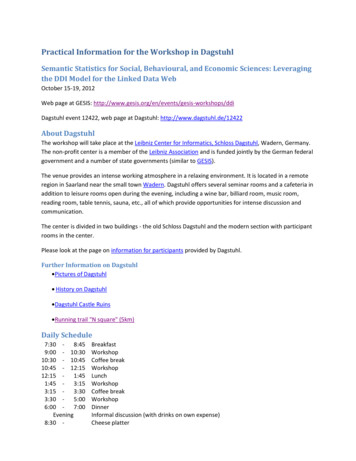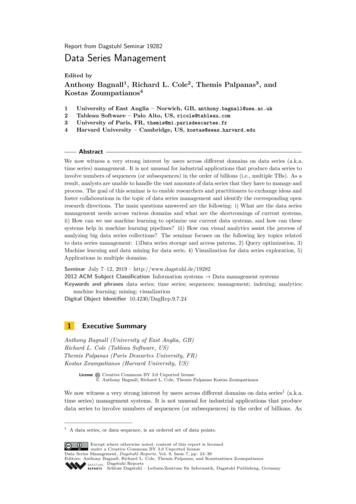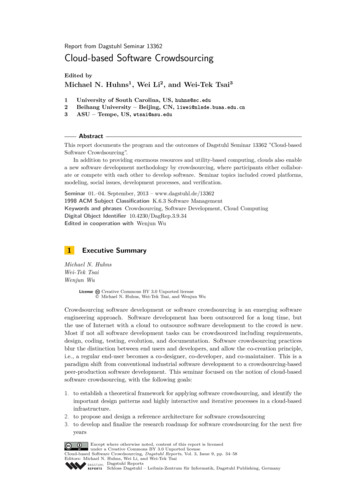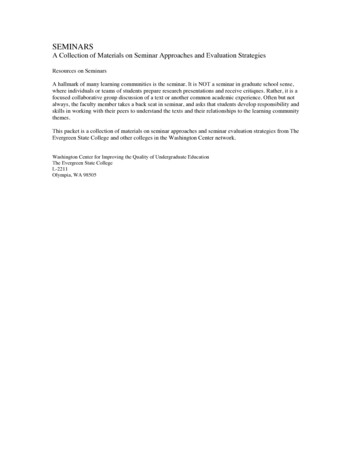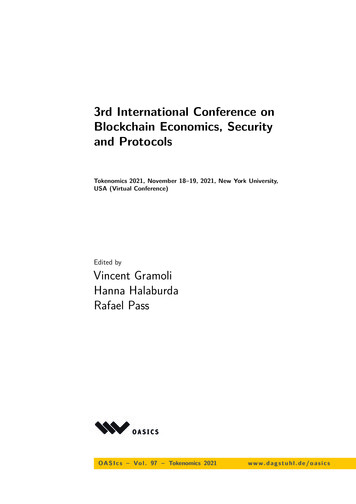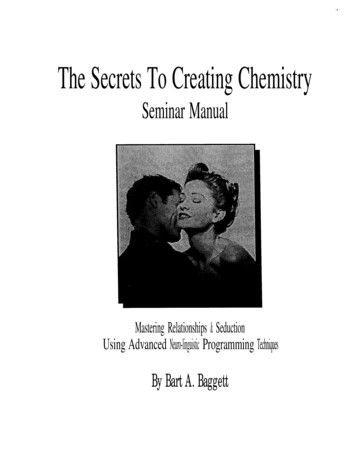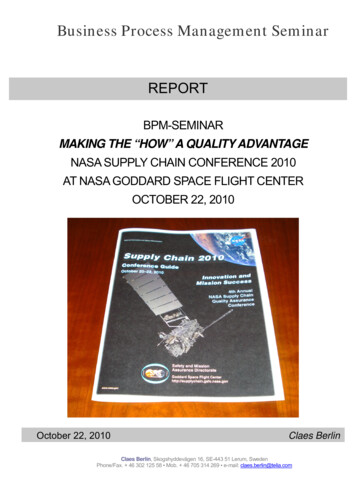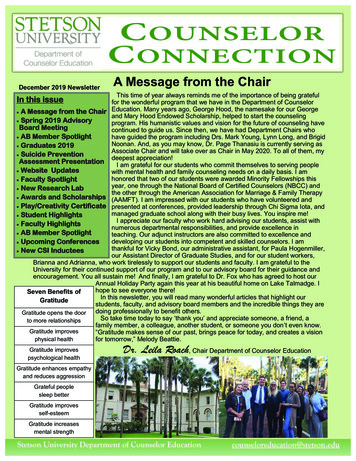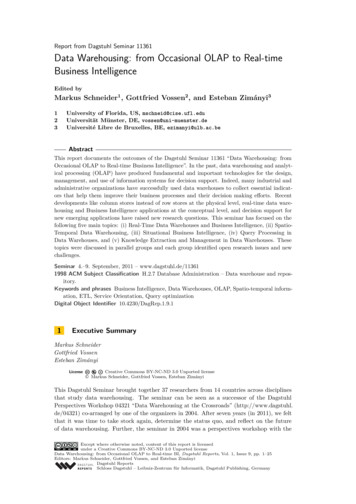
Transcription
Report from Dagstuhl Seminar 11361Data Warehousing: from Occasional OLAP to Real-timeBusiness IntelligenceEdited byMarkus Schneider1 , Gottfried Vossen2 , and Esteban Zimányi3123University of Florida, US, mschneid@cise.ufl.eduUniversität Münster, DE, vossen@uni-muenster.deUniversité Libre de Bruxelles, BE, ezimanyi@ulb.ac.beAbstractThis report documents the outcomes of the Dagstuhl Seminar 11361 “Data Warehousing: fromOccasional OLAP to Real-time Business Intelligence”. In the past, data warehousing and analytical processing (OLAP) have produced fundamental and important technologies for the design,management, and use of information systems for decision support. Indeed, many industrial andadministrative organizations have successfully used data warehouses to collect essential indicators that help them improve their business processes and their decision making efforts. Recentdevelopments like column stores instead of row stores at the physical level, real-time data warehousing and Business Intelligence applications at the conceptual level, and decision support fornew emerging applications have raised new research questions. This seminar has focused on thefollowing five main topics: (i) Real-Time Data Warehouses and Business Intelligence, (ii) SpatioTemporal Data Warehousing, (iii) Situational Business Intelligence, (iv) Query Processing inData Warehouses, and (v) Knowledge Extraction and Management in Data Warehouses. Thesetopics were discussed in parallel groups and each group identified open research issues and newchallenges.Seminar 4.–9. September, 2011 – www.dagstuhl.de/113611998 ACM Subject Classification H.2.7 Database Administration – Data warehouse and repository.Keywords and phrases Business Intelligence, Data Warehouses, OLAP, Spatio-temporal information, ETL, Service Orientation, Query optimizationDigital Object Identifier 10.4230/DagRep.1.9.11Executive SummaryMarkus SchneiderGottfried VossenEsteban ZimányiLicenseCreative Commons BY-NC-ND 3.0 Unported license Markus Schneider, Gottfried Vossen, Esteban ZimányiThis Dagstuhl Seminar brought together 37 researchers from 14 countries across disciplinesthat study data warehousing. The seminar can be seen as a successor of the DagstuhlPerspectives Workshop 04321 “Data Warehousing at the Crossroads” (http://www.dagstuhl.de/04321) co-arranged by one of the organizers in 2004. After seven years (in 2011), we feltthat it was time to take stock again, determine the status quo, and reflect on the futureof data warehousing. Further, the seminar in 2004 was a perspectives workshop with theExcept where otherwise noted, content of this report is licensedunder a Creative Commons BY-NC-ND 3.0 Unported licenseData Warehousing: from Occasional OLAP to Real-time BI, Dagstuhl Reports, Vol. 1, Issue 9, pp. 1–25Editors: Markus Schneider, Gottfried Vossen, and Esteban ZimányiDagstuhl ReportsSchloss Dagstuhl – Leibniz-Zentrum für Informatik, Dagstuhl Publishing, Germany
211361 – Data Warehousing: from Occasional OLAP to Real-time ParallelGroupsCoffee breakIBM troductionsGroupsCoffee breakShortParallelIntroductionsGroups18:00–· · ·ExcursiontoTrierParallelGroupsCoffee breakParallelGroupsDinnerFigure 1 Timetable of the seminarexclusive goal of predicting the possible future direction of data warehousing and OLAP.This seminar has a different scope and mainly dealt with current and recent research results.This does not exclude to look into the future and to determine what the field has achieved inthe meantime.The participants of the seminar were clustered around five thematic areas as followsReal-Time Data Warehouses and Business Intelligence,Spatio-Temporal Data Warehousing,Situational Business Intelligence,Query Processing in Data Warehousing, andKnowledge Extraction and Management in Data Warehouses.This clustering was arranged prior to the seminar so that participants came to the seminarwith short introductions describing both themselves and the research topics they work on,as well as identify challenging questions in these thematic areas. The whole Monday wasdevoted to these introductions.Tuesday and Thursday were devoted to parallel working groups, each group discussingthe state of the art in its thematic area and identifying the open questions. The organizersasked to each group to answer the following four questions1. Identify most pressing research issues.2. Is the topic purely industrial or also academic?3. Where do you expect to be 5 years from now?4. What would you want a new PhD student to work on?Further, longer research presentations were given within each group for focusing the groups’work around a common approach. Each group presented a short ongoing report of the workrealized in Wednesday morning, and a final presentation of their results on Friday morning.It is worth noting that the Data Warehouse domain is both an active research domain butalso drives a very intense activity in the industrial world. One objective of the seminar wasalso to establish bridges between these two communities. The seminar attracted participantsfrom major companies active in the Data Warehouse domain (Sybase, HP, IBM, and EMC).Another concrete step in this respect was an industrial presentation given on Wednesdaymorning by Knut Stolze, from IBM Germany.All five groups have committed to produce a paper to be published in a special issue of ajournal. After discussion among the participants, the organizers started negotiating with
Markus Schneider, Gottfried Vossen, and Esteban Zimányi3different journals about this possibility, and finally the journal chosen was the InternationalJournal of Data Warehouse and Mining. It is expected that the papers will be submitted tothe journal in January 2012 so that the publication of the special issue will be at the end of2012.11361
411361 – Data Warehousing: from Occasional OLAP to Real-time BI2Table of ContentsExecutive SummaryMarkus Schneider, Gottfried Vossen, Esteban Zimányi . . . . . . . . . . . . . . . .1Overview of TalksService Oriented BIAlberto Abello . . . . . . . . . . . . . . . . . . . . . . . . . . . . . . . . . . . . . . .7Data Mining for Business Intelligence: from Relational to Graph representationMarie-Aude Aufaure . . . . . . . . . . . . . . . . . . . . . . . . . . . . . . . . . . .7Open Research Areas in Data WarehousesCristina Ciferri . . . . . . . . . . . . . . . . . . . . . . . . . . . . . . . . . . . . . .8Spatial Data Warehouses (SDW): Research Topics and Open IssuesRicardo Ciferri . . . . . . . . . . . . . . . . . . . . . . . . . . . . . . . . . . . . . .8My Current Research InterestsMaria Luisa Damiani . . . . . . . . . . . . . . . . . . . . . . . . . . . . . . . . . .9Towards spatio-temporal datawarehousesMaria Luisa Damiani . . . . . . . . . . . . . . . . . . . . . . . . . . . . . . . . . .9Privacy and performance of cloud data warehousesJerome Darmont . . . . . . . . . . . . . . . . . . . . . . . . . . . . . . . . . . . . . 10BI/OLAP research themesTodd Eavis . . . . . . . . . . . . . . . . . . . . . . . . . . . . . . . . . . . . . . . . 10Knowledge Discovery & Management: My Point Of ViewCécile Favre . . . . . . . . . . . . . . . . . . . . . . . . . . . . . . . . . . . . . . . . 10Research InterestsCecile Favre . . . . . . . . . . . . . . . . . . . . . . . . . . . . . . . . . . . . . . . .11Column Stores and Query Processing for real-time BIDavid Fekete . . . . . . . . . . . . . . . . . . . . . . . . . . . . . . . . . . . . . . .11Collaborative Business IntelligenceMatteo Golfarelli . . . . . . . . . . . . . . . . . . . . . . . . . . . . . . . . . . . . .11Research on DW, OLAP and MiningLeticia I. Gomez . . . . . . . . . . . . . . . . . . . . . . . . . . . . . . . . . . . . . 12Sequential OLAPChristian Koncilia . . . . . . . . . . . . . . . . . . . . . . . . . . . . . . . . . . . . 12Data warehouse mining: what about mining query logs?Patrick Marcel . . . . . . . . . . . . . . . . . . . . . . . . . . . . . . . . . . . . . . 12Open Business IntelligenceJose-Norberto Mazon . . . . . . . . . . . . . . . . . . . . . . . . . . . . . . . . . . . 13Mining Association Rules from Data CubesRokia Missaoui . . . . . . . . . . . . . . . . . . . . . . . . . . . . . . . . . . . . . . 13BI Research Overview Gong ShowTorben B. Pedersen . . . . . . . . . . . . . . . . . . . . . . . . . . . . . . . . . . . .14
Markus Schneider, Gottfried Vossen, and Esteban Zimányi5Efficient estimation of Joint Queries from Multiple OLAP DatabasesElaheh Pourabbas . . . . . . . . . . . . . . . . . . . . . . . . . . . . . . . . . . . . .14Spatial and Spatio-Temporal Data WarehousingMarkus Schneider . . . . . . . . . . . . . . . . . . . . . . . . . . . . . . . . . . . . .14IBM Smart Analytics Optimizer - Technical IntroductionKnut Stolze . . . . . . . . . . . . . . . . . . . . . . . . . . . . . . . . . . . . . . . . 15Business Intelligence 2.0: A general overviewJuan Trujillo . . . . . . . . . . . . . . . . . . . . . . . . . . . . . . . . . . . . . . . 15Data Warehouse design and consistency through trace metamodels on a hybridapproachJuan Trujillo . . . . . . . . . . . . . . . . . . . . . . . . . . . . . . . . . . . . . . . 16Research in Data Warehousing, OLAP & BeyondAlejandro Vaisman . . . . . . . . . . . . . . . . . . . . . . . . . . . . . . . . . . . . 16Near-Real-Time & Evolving ETLPanos Vassiliadis . . . . . . . . . . . . . . . . . . . . . . . . . . . . . . . . . . . . .17Business Intelligence as a Service, in the CloudGottfried Vossen . . . . . . . . . . . . . . . . . . . . . . . . . . . . . . . . . . . . .17Some not fully solved problems in data warehouse researchRobert Wrembel . . . . . . . . . . . . . . . . . . . . . . . . . . . . . . . . . . . . . .17What is Spatio-Temporal Data Warehousing?Esteban Zimányi . . . . . . . . . . . . . . . . . . . . . . . . . . . . . . . . . . . . . 18Working GroupsSituational BIStefano Rizzi . . . . . . . . . . . . . . . . . . . . . . . . . . . . . . . . . . . . . . . 18Situational BI RevisitedStefano Rizzi . . . . . . . . . . . . . . . . . . . . . . . . . . . . . . . . . . . . . . . 19On-demand self-service BITorben B. Pedersen . . . . . . . . . . . . . . . . . . . . . . . . . . . . . . . . . . . . 19Research Problems in Data WarehousingMarkus Schneider . . . . . . . . . . . . . . . . . . . . . . . . . . . . . . . . . . . . . 19Query Processing in Data WarehousesAnisoara Nica . . . . . . . . . . . . . . . . . . . . . . . . . . . . . . . . . . . . . . . 20Query Processing in the Elastic CloudAnisoara Nica . . . . . . . . . . . . . . . . . . . . . . . . . . . . . . . . . . . . . . . 20Knowledge Discovery and Management in Data warehousesRokia Missaoui . . . . . . . . . . . . . . . . . . . . . . . . . . . . . . . . . . . . . . 20Knowledge Discovery and Management in Data warehouses: Final reportRokia Missaoui . . . . . . . . . . . . . . . . . . . . . . . . . . . . . . . . . . . . . .21Right time BI frameworkRobert Wrembel . . . . . . . . . . . . . . . . . . . . . . . . . . . . . . . . . . . . . .2111361
611361 – Data Warehousing: from Occasional OLAP to Real-time BIOpen ProblemsReal-Time Data Warehouses and Business Intelligence . . . . . . . . . . . . . . . .21Spatio-Temporal Data Warehouses . . . . . . . . . . . . . . . . . . . . . . . . . . . 22Situational Business Intelligence . . . . . . . . . . . . . . . . . . . . . . . . . . . . 23Query Processing in Data Warehouses: Elasticity in Cloud Databases . . . . . . . 23Knowledge Extraction and Management in Data Warehouses . . . . . . . . . . . .24Participants . . . . . . . . . . . . . . . . . . . . . . . . . . . . . . . . . . . . . . . . . 25
Markus Schneider, Gottfried Vossen, and Esteban Zimányi33.17Overview of TalksService Oriented BIAlberto Abello (Universitat Politècnica de Catalunya – Barcelona, ES)LicenseCreative Commons BY-NC-ND 3.0 Unported license Alberto AbelloThe traditional way to manage Information Technologies (IT) in the companies is having adata center, and licensing monolithic applications based on the number of CPUs, allowedconnections, etc. This also holds for Business Intelligence environments. Nevertheless,technologies have evolved and today other approaches are possible. Specifically, the serviceparadigm allows to outsource hardware as well as software in a pay-as-you-go model. In thiswork, we will introduce the concepts related to this paradigm and analyze how they affectBusiness Intelligence (BI). We analyze to which extent it is possible to consider BusinessIntelligence just a service and use techniques like Cloud Computing, Service OrientedArchitectures (SOA) and Business Process Modeling (BPM). Finally, we store the other wayround. Since special attention must be paid to service companies’ characteristics and how toadapt BI techniques to enhance services.3.2Data Mining for Business Intelligence: from Relational to GraphrepresentationMarie-Aude Aufaure (Ecole Centrale – Paris, FR)LicenseCreative Commons BY-NC-ND 3.0 Unported license Marie-Aude AufaureTraditional data mining methods, e.g. clustering, association rules, etc. are based on atabular representation of input data and mainly ignore the relations between objects. Data,always growing, are mainly unstructured (80distributed and come from heterogeneous datasources in an unpredictable way. Business Intelligence methods and tools need to take this bigdata challenge into account. Graphs are everywhere (social networks, web, biology, etc.) andcan be considered as a way for managing structured, semi-structured and unstructured data.This structure can be used for traversing linked information, finding shortest paths, doingsemantic partition, recommending and discovering potential interesting linked information.Methods and tools can be defined to exploit the graph structure of large repositories suchas digital libraries, web, databases or data warehouses with their associated metadata.This presentation focuses on the extraction of graphs from relational databases and theiraggregation. Open problems still remain: many graph models exist so the most appropriateone has to be chosen, how can we combine data mining methods with graphs algorithms tofind communities that not only takes into account links between individuals, but also theirsimilarities based on their own attributes, how can we summarize and aggregate these graphsand maintain their consistency.11361
811361 – Data Warehousing: from Occasional OLAP to Real-time BI3.3Open Research Areas in Data WarehousesCristina Ciferri (University of Sao Paulo, BR)LicenseCreative Commons BY-NC-ND 3.0 Unported license Cristina CiferriIn this talk, I highlight my main research areas of interest, especially those related to datawarehousing. Regarding geographic data warehouses, I have proposed: (i) the SB-indexand the HSB-index structures; (ii) the Spadawan and the Spatial Star Schema benchmarks;and (iii) a systematic way to investigate spatial data redundancy. Another research areaof interest is the storage and recovery of images in data warehousing environments. I havebeen investigating how to store images and how to perform the ETL process, as well as howto handle aggregation levels and how to provide efficient query processing over image datawarehouses. I also have interest in horizontal and vertical fragmentation of data warehouses,view materialization using OLAP signatures and GRASP, and analytical processing overXML documents.Finally, other research topics include mining of medial data, data integration and provenance, and the proposal of index structures for biological databases, complex data such asimage, audio and video, and time series data.3.4Spatial Data Warehouses (SDW): Research Topics and OpenIssuesRicardo Ciferri (University of Sao Carlos, BR)LicenseCreative Commons BY-NC-ND 3.0 Unported license Ricardo CiferriIn this talk, I presented the main research topics in data warehouse area that the researchersof the Database Group (DBG) of the Federal University of São Carlos (UFSCar), Brazil,have been investigating. The main research topic is spatial data warehouse. For this topic,it was proposed techniques to improve SOLAP query processing performance over starschemas through specialized indices, such as the SB-index and the HSB-index. Also, animproved strategy to process drill-across SOLAP queries was briefly described in this talk.The performance evaluation of SOLAP query processing also was investigated through theproposal of two benchmarks:The Spadawan Benchmark and The Spatial Star Schema Benchmark.Nowadays, the Database Group of the Federal University of São Carlos (Brazil) isinvestigating data warehouses that store vague spatial objects and spatio-temporal datawarehouse performance.
Markus Schneider, Gottfried Vossen, and Esteban Zimányi3.59My Current Research InterestsMaria Luisa Damiani (Università di Milano, IT)LicenseCreative Commons BY-NC-ND 3.0 Unported license Maria Luisa DamianiThis brief contribution is to illustrate my area of research and some research questions relatedto the use of spatial data warehouses. My current research is carried out in two main areas,both related to spatial and spatio-temporal data management. The first addresses issuesrelated to location-based security and location privacy, i.e., how to use location informationto regulate the access to sensitive resources and how to preserve the privacy of personalposition data, respectively. The second line is concerned with spatio-temporal data modeling,in particular the conceptual modeling of spatial datawarehouse and the recent paradigm ofsemantic trajectories, i.e., how to enrich the movement information with semantics. Spatialdata warehouses have a potential in all these applications. Spatial data warehousing has beena “promising” area of research since early 2000. The key question is whether this promisehas turned into a concrete result. While map visualization is extensively used in conventionaldata warehouses, it is still not clear whether any real progress has been made in the directionof building real and large scale spatial data warehouses. Moreover, it is not clear whether theparadigm founded on the notion of dimension measure and fact is sufficient to deal with thespecific features of novel spatio-temporal representations like semantic trajectories. Theseare questions that are worth being discussed.3.6Towards spatio-temporal datawarehousesMaria Luisa Damiani (Università di Milano, IT)LicenseCreative Commons BY-NC-ND 3.0 Unported license Maria Luisa DamianiThe widespread use of positioning technologies makes it relatively easy to track objects acrossindoor and outdoor settings. Large amounts of data on the traces of entities can be easilycollected, possibly reporting not only their time varying positions but also information aboutthe context in which the movement takes place, for example acquired through sensors. Inthis way the behavior of moving entities can be more easily analyzed. An emerging paradigmfor the representation of the behavior of moving entities is that of semantic trajectories. Asemantic trajectory is a trajectory which is temporally bounded (i.e., has a start and anend) and which represents the movement carried out by an object for some specific purpose.A semantic trajectory is a sequence of stops and moves where both stops and move areannotated semantically, for example a stop can represent a railway station while the movecan be a particular train line. The question we pose is how to obtain aggregated informationout from large bulks of semantic trajectories so as to build models of collective behavior. Thiscalls for the definition of novel OLAP algebras defined over sequences of multidimensionaldata and integrating visual analytics functionalities.11361
1011361 – Data Warehousing: from Occasional OLAP to Real-time BI3.7Privacy and performance of cloud data warehousesJerome Darmont (Université Lumière Lyon 2, FR)LicenseCreative Commons BY-NC-ND 3.0 Unported license Jerome DarmontWe address in this presentation two critical issues in cloud BI. With respect to data privacyand availability, we distribute data over several cloud service providers (CSP) using Shamir’sSecret Sharing cryptographic scheme so that:(1) each CSP cannot exploit the data it stores; (2) a majority of CSP need to bandtogether to break the secret, or fail at the same time to render data unavailable. Withrespect to query performance, we propose to balance the increase of CPU power (and cost)with classical performance optimization data structures, i.e., materialized views (at a storagecost). Our aim being to find the best cost tradeoff, we designed cost models that help outputan optimal configuration of CPU instances and materialized views, thus providing flexiblecontrol over both power and budget.3.8BI/OLAP research themesTodd Eavis (Concordia University – Montreal, CA)LicenseCreative Commons BY-NC-ND 3.0 Unported license Todd EavisIn this talk I provide an overview of a number of current research issues in the OLAP/BIdomain. Topics include: Parallel Computing, Indexing, query ptimization compression,exploitation of GPUs, OLAP languages, native language (Java) querying, Query rewriting,Web-based interfaces, drag and drop BI queries, and conceptual modelling.3.9Knowledge Discovery & Management: My Point Of ViewCécile Favre (Université Lumière Lyon 2, FR)Creative Commons BY-NC-ND 3.0 Unported license Cécile FavreURL http://eric.univ-lyon2.fr/ cfavre/DAGSTUHL/Favre DAGSTUHL KnowledgeDiscovery&Management MyPointOfView.pdfLicenseThis talk was prepared in order to begin the discussion in the group. This includes (1) afirst list for using Knowledge Discovery and Management in Data Warehouses, (2) the detailabout my own works concerning the topics of the group, (3) the links with the other groups,and at the end (4) other issues for the group.
Markus Schneider, Gottfried Vossen, and Esteban Zimányi3.1011Research InterestsCecile Favre (Université Lumière Lyon 2, FR)LicenseCreative Commons BY-NC-ND 3.0 Unported license Cecile FavreThis is an overview of my past, current and future research work related to datawarehousing.This includes Personalization in Data Warehouses, Data Warehouse Modeling and thecombination of Social Networks and Data Warehouses.3.11Column Stores and Query Processing for real-time BIDavid Fekete (Universität Münster, DE)LicenseCreative Commons BY-NC-ND 3.0 Unported license David FeketeColumn Stores, as column-based Database Management Systems (DBMS), have come to beoften regarded as alternative to typical row-based DBMS (Row Stores) in Data Warehousing(DWH) and Business Intelligence (BI) scenarios. Column Stores promise to improve readperformance in those read- intensive, analytical (On-Line Analytical Processing, OLAP)scenarios significantly. But especially query processing is an integral part in realizing thisspeed-up potential and subject to many optimization techniques, like Block Iteration, LateMaterialization or Compression. A query executor has to utilize the columnar databasestructure to enable the promised performance advantages. On the way from “occasionalOLAP” to “real-time” BI there are several possible issues with regard to query processing.Those include the contribution of these Column Store technologies to real-time BI or theimpact of novel hardware technologies, such as Solid State Drives (SSD) and multi-coreCPUs.3.12Collaborative Business IntelligenceMatteo Golfarelli (Università di Bologna, IT)LicenseCreative Commons BY-NC-ND 3.0 Unported license Matteo GolfarelliCooperation is seen by companies as one of the major means for increasing flexibility andinnovating. Business intelligence (BI) platforms are aimed at serving individual companies,and they cannot operate over networks of companies characterized by an organizational,lexical, and semantic heterogeneity. In this presentation we summarize different approachesto collaborative BI and we propose a framework, called Business Intelligence Network (BIN),for sharing BI functionalities over complex networks of companies that are chasing mutualadvantages through the sharing of strategic information. A BIN is based on a networkof peers, one for each company participating in the consortium. Peers are equipped withindependent BI platforms that expose some querying functionalities aimed at sharing businessinformation for the decision-making process. After proposing an architecture for a BIN, weoutline the main research issues involved in its building and operating.11361
1211361 – Data Warehousing: from Occasional OLAP to Real-time BI3.13Research on DW, OLAP and MiningLeticia I. Gomez (Instituto Tecnológico de Buenos Aires, AR)LicenseCreative Commons BY-NC-ND 3.0 Unported license Leticia I. GomezWe discuss different challenges in Business Intelligence. Traditional Data Warehouse andOLAP tools store and manipulate strings, numbers and timestamp data types in a native way.Incorporating new data types in DW enriches the capability of analysis. For instance, spatiotemporal data recorded by GPS and RFID sensors can be used for discovering trajectorieshidden patterns. In addition, as new types of data are incorporated into DW and Mining,novel techniques have to be proposed related to physical and logical design of data as well asnew forms of human interaction. We showed briefly the idea of some related projects.3.14Sequential OLAPChristian Koncilia (Universität Klagenfurt, AT)LicenseCreative Commons BY-NC-ND 3.0 Unported license Christian KonciliaAlthough Business Intelligence is a still a hot topic in computer science, little effort has beenput on how to analyze sequences in data warehouses.In my talk I presented a novel approach which enables the user to analyze sequentialdata within a standard OLAP environment. This approach consists of two core functions(SOLAP() and RTA() where RTA is short for “Real Time Axis”) which both return astandard OLAP cube. Hence, the user can still use all the well-known OLAP operationslike drill-down, roll-up, slice, etc. to analyze the cube. Furthermore, this approach may beapplied to all data warehousing solutions.3.15Data warehouse mining: what about mining query logs?Patrick Marcel (Université de Tours – Blois, FR)LicenseCreative Commons BY-NC-ND 3.0 Unported license Patrick MarcelThis presentation gives a brief overview of the researches lead at the computer science lab ofUniversité François Rabelais Tours on mining OLAP query logs.Two examples are presented. In the first one, a joint work with Università di Bologna,association rules are extracted from a user’s query log for presonalising the user’s queries onthe fly.In the second one, a multi user log is analysed to recommend queries for supportingdiscovery driven analyses.Some research perspectives around OLAP log mining are underlined.
Markus Schneider, Gottfried Vossen, and Esteban Zimányi3.1613Open Business IntelligenceJose-Norberto Mazon (Univ. of Alicante, ES)LicenseCreative Commons BY-NC-ND 3.0 Unported license Jose-Norberto MazonCitizens demand an increasingly transparent behavior of public institutions.Importantly, transparency implies that public data should be available with the aim ofproviding the greatest benefit to the wider society through an active participation of citizens.Therefore, public data should be freely available to be easily used, reused and redistributedby anyone, i.e. open data. Consequently, open data are generally shared as a raw datawhich, unfortunately, prevents non-expert citizens from analyzing them to acquire actionableinformation. Mechanisms that allow citizens to analyze and understand open data in auser-friendly manner are thus highly required.To this aim, the concept of Open Business Intelligence (OpenBI) is introduced. OpenBIfacilitates non-expert users to (i) analyze and visualize open data, thus generating actionableinformation by means of reporting, OLAP analysis, dashboards or data mining; and to (ii)share the new acquired information as open data to be reused by anyone. As a consequence,OpenBI requires the development of systematic approaches for guiding non-expert users inobtaining and sharing the most reliable knowledge from the available open data. Finally, itis worth noting that OpenBI has to deal with several research challenges: the extraction andintegration of heterogeneous open data sources by non-expert users (as citizens), tacklingdata quality issues in a user-friendly manner, intuitive data visualization, smooth integrationof unstructured data, and so on.3.17Mining Association Rules from Data CubesRokia Missaoui (Université du Québec en Outaouais, CA)LicenseCreative Commons BY-NC-ND 3.0 Unported license Rokia MissaouiSubstantial work has been conducted in knowledge discovery from data warehouses. Thisincludes (but is not limited to) outlier detection in multidimensional data, cubegradegeneration, constrained gradient analysis, association rule mining, and discovery-drivenexamination of cubes. To the best of our knowledge, Kamber et al. were the first researcherswho addressed the issue of mining association rules (ARs) from multidimensional data. Theyintroduced the concept of metarule-guided mining which consists in using rule templatesdefined by users in order to guide the mining process.The objective of the present talk is to show that triadic concept analysis can be used as aformal data mining framework to generate clusters (closed trisets) and triadic associationrules from data cubes in an efficient and meaningful way. The merits of triadic associationrules over dyadic ones lie in the fact that they represent patterns in a more compact andmeaningful way than association rules extracted from one of the possible
Data Warehousing: from Occasional OLAP to Real-time Business Intelligence Edited by Markus Schneider1, . Topics include: Parallel Computing, Indexing, query ptimization compression, va)querying,Queryrewriting, tualmodelling.
